The lifespan of personal protective equipment (PPE) depends on several factors, including the working environment, frequency of use, and the type of PPE. Different regions have established specific guidelines based on local conditions. For example, in Shandong Province, the usage period for safety helmets in different industries is clearly defined: 36 months for metallurgical rolling mill operations, 48 hours for cold water work, 24 months for coal mining and civil construction, and 12 months for geological survey tasks such as installation, drilling, and sampling. These regulations vary by region, reflecting the diverse needs and risks across different industries.
First, let's look at the typical service life of common special protective equipment:
1. Safety Belts
Safety belts should be inspected after two years of use. If they pass the test, they can continue to be used. However, any tested belt must replace its safety rope before being reused. Frequent users should regularly check the appearance of the belt. If any damage or wear is found, it should be replaced immediately. A safety belt typically lasts between 3 to 5 years.
2. Anti-static Shoes and Overalls
According to GB12014-89, anti-static clothing must be worn with anti-static shoes specified in GB4385. Due to repeated washing, the anti-static performance of overalls may decrease. In high-temperature, high-intensity environments where washing is frequent, companies should set a shorter service life. Also, anti-static shoes should not be tested for more than 200 hours; if they fail, they must be discarded.
3. Insulating Shoes and Gloves
Insulating shoes include leather, rubber, and plastic types. Companies can determine their own usage periods based on labor intensity and environment. However, these items should be stored properly—after 18 months, they need electrical testing. If the soles are damaged, they cannot be used. Insulating gloves should be tested every six months. Before each use, perform a self-test by blowing air into them. If they fail, they must not be used again.
4. Hearing Protection Devices
Hearing protectors include earplugs, earmuffs, and helmets. Helmets offer the best noise reduction, blocking both air-conducted and bone-conducted sound. Earmuffs are less effective, while earplugs provide minimal protection, usually reducing noise by only 10–20 dB in the 1000–2000 Hz range. They are suitable for lower noise environments but not for high-risk areas.
Second, the retirement principles for special protective equipment:
1. Degree of Corrosion
Depending on the operation, PPE wear can be classified as heavy, medium, or light corrosion. This classification reflects the working environment and the nature of the job.
2. Loss of Protective Function
The degradation of protective function can be categorized as minor, moderate, or severe. This indicates how well the equipment can still serve its purpose.
3. Durability
Some PPE is durable, while others are only medium or short-lived. Durability reflects the material quality and overall performance of the protective gear.
Third, there are several common misconceptions about using personal protective equipment:
Myth #1: PPE is optional
Experts emphasize that PPE helps reduce occupational hazards. According to the Occupational Disease Prevention Act, employers must provide appropriate PPE, and employees are required to use it correctly.
Misunderstanding #2: No smell means no danger
Many harmful substances are odorless and colorless. Relying solely on sensory perception can lead to serious health risks. It’s essential to follow safety protocols rather than trust your senses alone.
Myth #3: Gauze masks prevent dust
Gauze masks are not suitable for dust protection. Even thick gauze masks cannot filter out fine dust particles that cause pneumoconiosis. Special dust masks are necessary for proper protection.
Myth #4: Medical masks protect against toxins
Medical masks are designed to block droplets, not toxic gases. For chemical exposure, specialized respirators with activated carbon filters are required.
Myth #5: Dust masks can be washed and reused
Dust masks are not washable. Their filters rely on electrostatic charges, which are lost after washing. This reduces their effectiveness and increases the risk of exposure to harmful particles.
PPE is a last line of defense. Ideally, workplaces should prioritize engineering controls and advanced technology to eliminate hazards at the source. PPE should be considered as an additional measure when other protections are insufficient. Remember, no single piece of equipment is perfect. Each has its limitations, and it's crucial to understand its intended use and environment.
China Labor Insurance Network
LED emergency light have been divided into two heads emergency lights , bulkhead emergency lights , emergency ceiling lights and emergency bulbs . The role of emergency lights is an emergency state evacuating people , generally used in public places . All emergency lights use LED source , its advantages are high brightness , low power consumption , LED lighting effect than the traditional light source energy saving nearly 80% .

Led Emergency Light,,Recessed Emergency Light,Automatic Emergency Light
Jiangmen City Pengjiang District Qihui Lighting Electrical Appliances Co., Ltd , https://www.qihuilights.com